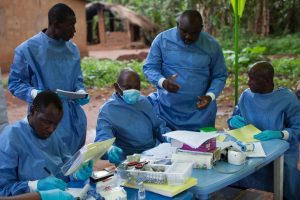 An experimental vaccine against Ebola completely protected recipients from the deadly virus near the end of the recent epidemic in West Africa reported researchers.
An experimental vaccine against Ebola completely protected recipients from the deadly virus near the end of the recent epidemic in West Africa reported researchers.
The same strategy was used that was also used for the eradication in the 1970s of smallpox. Known as ring vaccination, it vaccinates people who have had contact with patients and the contacts of contacts.
It worked, said the team the World Health Organization led.
It is not surprising, researchers had worked on a vaccine for Ebola for years but due to the virus only causing small, occasional outbreaks, it was always difficult to test.
In addition, there were not any governments or companies that invested time or money that was needed for the vaccine to be developed.
Then in the latter part of 2013, the epidemic began in Liberia, Guinea and Sierra Leone. Before it could be stopped completely early in 2016, it infected more than 28,000 people and killed over 11,000.
Researchers rushed a number of vaccines into production cycles.
This particular vaccine was developed by Canada’s Public Health Agency, which in turned licensed it to NewLink Genetics a private company. Merck & Co. the pharmaceutical giant purchased the license and is manufacturing the vaccine.
It uses vesicular stomatitis virus or VSV, which is an animal virus. The virus is not harmful to people. Makers of vaccine genetically engineered the virus to carry a small piece of the DNA of Ebola to stimulate a response from the immune system.
Medical experts, who helped the vaccine campaign to eradicate the smallpox virus, designed a trial using ring vaccination.
Once all that work was completed, the epidemic has already started to wane. It is difficult testing vaccines if the disease being tested is no longer spreading, but the team of experts tried the vaccine in a Guinea coastal region where cases of Ebola had still been reported on a regular basis.
Through direct contact, the virus is able to spread, either between people or bodily fluids like blood from a person ill with the virus or who died from the virus.
Researchers were able to find every person who might have come into contact with a case and that included members of the family and friends.
Then they located people who were in contact with the others and each of the rings ended up including close to 80 people.
Experts stopped the trial when it was apparent it did protect recipients from the virus.
